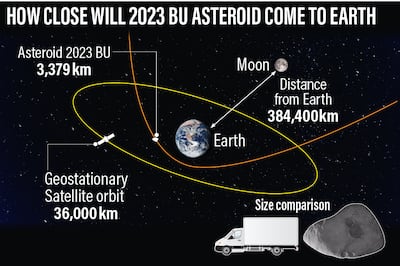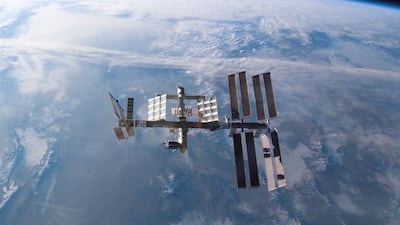Earth is about to have a very close encounter with an asteroid.
Early on Friday morning, the 2023 BU asteroid is expected to make “one of the closest approaches by a known near-Earth object ever recorded”, US space agency Nasa said.
The small asteroid, estimated to measure somewhere from 3.5 to 8.5 metres in width, will fly over the southern tip of South America at about 4.30am UAE time, just 3,600km above the planet’s surface — moving well within the orbit of its satellites.
But there is no risk of the asteroid hitting Earth, Nasa said.
And if it did, the celestial body would just turn into a fireball and disintegrate in the atmosphere, with some debris potentially falling as small meteorites.

The asteroid was discovered by amateur astronomer Gennadiy Borisov from his Margo observatory in Nauchnyi, Crimea, on Saturday.
Nasa’s Scout impact hazard assessment system, part of the Centre for Near Earth Object Studies in Southern California, quickly predicted the near miss, it said. The centre calculates every known near-Earth asteroid orbit.
“Scout quickly ruled out 2023 BU as an impactor, but despite the very few observations, it was nonetheless able to predict that the asteroid would make an extraordinarily close approach with Earth,” said Davide Farnocchia, a navigation engineer at JPL who developed Scout.
“In fact, this is one of the closest approaches by a known near-Earth object ever recorded.”
The 2023 BU asteroid will come so close that its path around the Sun is expected to be significantly altered, Nasa said. Any asteroid in Earth’s proximity can change trajectory due to Earth’s gravity.
Before encountering Earth, the asteroid’s orbit around the Sun was similar to Earth’s, taking 359 days to complete its circuit.
After its encounter, the asteroid’s orbit will be more elongated, moving it out to about halfway between Earth’s and Mars’s orbits at its farthest point from the Sun. The asteroid will then complete one orbit every 425 days, Nasa said.
Here the asteroid's position in space according to TheSkyLive.


